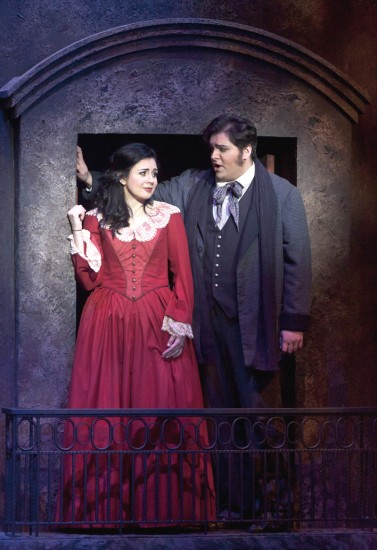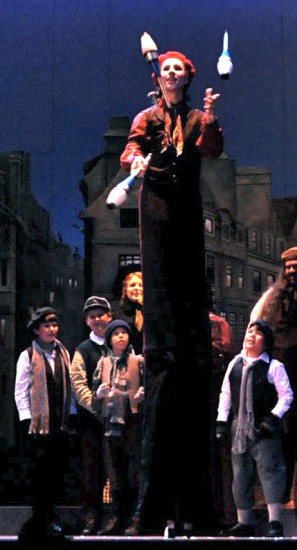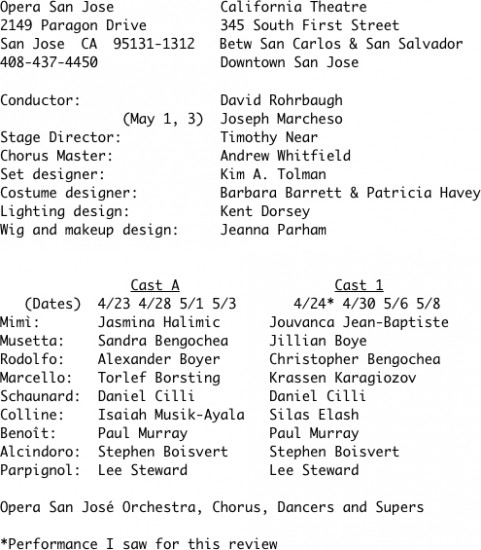
That’s what Opera San JosÉ has to say on their La Bohème web page – and I won’t argue with a single word of it.
Puccini was a craftsman. Previous great Italian opera composers would produce one, two, sometimes three operas a year; Puccini averaged almost 5 years for every opera. And it shows. Every note, every phrase of his music; every word, every action on stage – they are all in perfect harmony with each other, with what has gone before and with what is to come. All of this craftsmanship is brought to perfection in La Bohème.
The Director (Timothy Near), Maestro David Rohrbaugh, and the talented singer-actors on stage yesterday caught this unity from the very beginning. No sooner had the overture started than the curtain went up to reveal the poet Rodolfo (Christopher Bengochea) and the musician Marcello (Krassen Karagiozov) hard at work in the young bohemians’ garret.
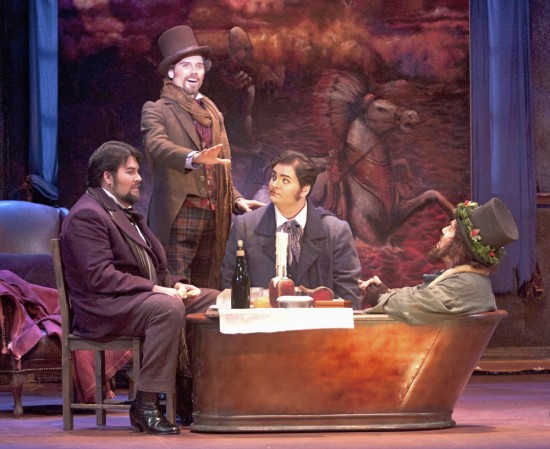
The four bohemians dine at home: (L-R) Marcello (Torlef Borsting), Schaunard (Daniel Cilli), Rodolfo (Alexander Boyer), Colline (Isaiah Musik-Ayala); photo by Robert Shomler
Kudos to the set designer (Kim A. Tolman) and the whole set construction team for that garret. Three things that particularly caught my attention: Marcello’s painting, the bathtub, and the balcony. In all previous productions I have seen, his canvas is on an ordinary easel, usually turned so that the audience doesn’t see the actual painting; here the easel goes from floor to ceiling and we see the painting in all its splendor. Presumably the tub plays its traditional role on Saturday nights, but here it is pressed into utilitarian use as both a table and a recliner chair.
The balcony is at the very front of the stage on the audience-right side, directly in front of our seats D2 and D4. The presumed interior hallway separating it from the garret is only a couple of feet long, but it makes an effective way of focusing on the singers for an occasional duet or solo; it also serves as a platform for communicating with the street below.
(A brief aside on the casting and the photographs; Opera San JosÉ double-casts most of its major roles, as shown in the table at the end. To avoid any opprobrium of second-class status, they are labeled Cast 1 and Cast A. I saw Cast 1 yesterday and my review is based on that performance. However, I plan to attend again next Sunday when Cast A will be on stage, so I felt free to include some pictures of that cast when they were more appropriate to the text.)
OK, back to the opening curtain. Marcello is on a step ladder working on the top part of his painting and making rapid sweeping brush strokes perfectly appropriate to the scale of the canvas and to the crashing staccato chords of the orchestra. An exciting beginning to the best Act 1 I’ve ever seen.
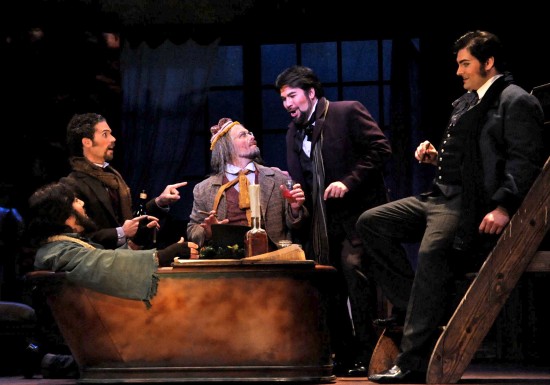
The fast pace and excitement continued with the arrival of the philosopher Colline (Silas Elash) and the musician Schaunard (Daniel Cilli) with his financial windfall. Further comedy is provided by the landlord Benoé®t (Paul Murray) demanding but not getting his rent.
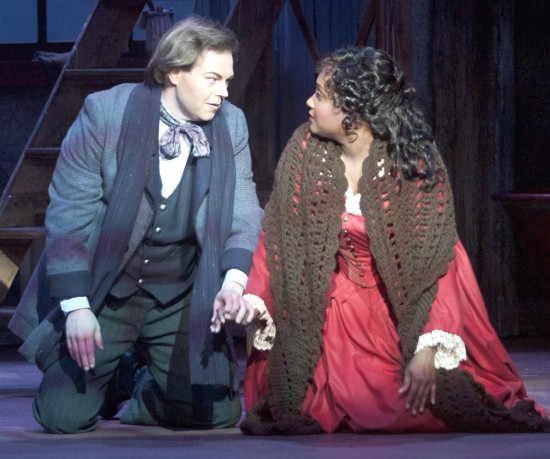
Rodolfo (Christopher Bengochea) and Mimi (Jouvanca Jean-Baptiste) hunt for her key; photo by Robert Shomler
When Mimi (Jouvanca Jean-Baptiste) first enters seeking a light for her candle, I confess that my first thought was, “No way can that healthy-looking young woman possibly be dying of consumption.” However, her lovely expressive face with its soulful eyes and her beautiful soprano voice soon had me under her spell and I totally forgot those early qualms.
After an amazingly brief time for a total scene change, we plunged into Act II at the crowded Latin quarter. Musetta (Jillian Boye) of course tries to steal the show, but Mimi manages to get a certain amount of attention.

The four bohemians are happy to have Mimi join them; (L-R) Schaunard: (Daniel Cilli), Colline: (Silas Elash), Marcello (Krassen Karagiozov), Mimi (Jouvanca Jean-Baptiste), Rodolfo: (Christopher Bengochea); Image by Pat Kirk Photography
As seems to always be the case, the crowd scene was organized chaos. The stage was jammed with people doing all sorts of motions, but the blocking was impeccable.

Local children swarm around Parpignol (Lee Steward), a strolling toy vendor. Image by Pat Kirk Photography
The children’s chorus were a particular delight. I know it sounds like an oxymoron, but they were both natural and well-behaved.
There is a certain point in the music of Act II where it is traditional to have some sort of a novelty performer. That role was well-filled here by William Martin, shown above faultlessly juggling three clubs while balanced on long stilts.
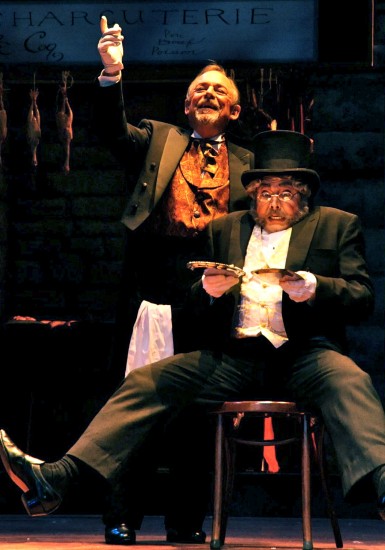
Alcindoro (Stephen Boisvert) returns to the cafe, only to be met by the head waiter (Stephen Howes) and an enormous bill. Image by Pat Kirk Photography
If I remember correctly, in all previous productions I have seen the roles of Benoé®t and Alcindoro are played by the same singer. Here, however, Paul Murray is cast as the landlord and Stephen Boisvert as Musetta’s sugar daddy; they did however, sing in both casts.
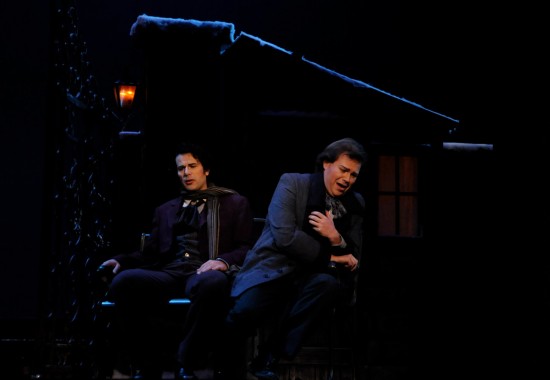
Marcello (Krassen Karagiozov) hears the other side of the story from Rodolfo (Christopher Bengochea). Image by Pat Kirk Photography
If one ever hopes to graduate from a Reviewer to a Critic, one must always find some fault with a production, no matter how trivial. Therefore, I report that there was a great paucity of snowfall in Act III. At one point a few token flakes drifted down, but that quiet plink-plink music symbolizes gentle snowfall. No wind – not too cold – but gentle and soft creating a mood of peaceful serenity which imparts a subtle tension with the dramatic human emotion expressed there.
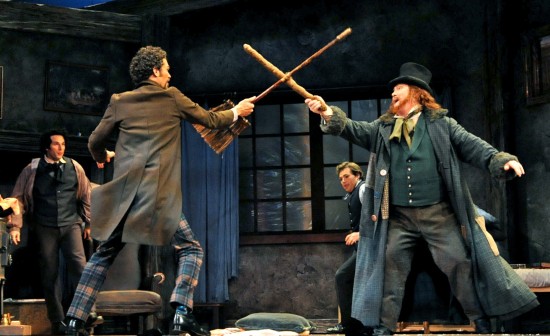
The friends try to forget their worries with a little humor and play-fighting. (L-R) Marcello (Krassen Karagiozov), Schaunard (Daniel Cilli) with the broom, Rodolfo (Christopher Bengochea), Colline (Silas Elash) with the baguette; Image by Pat Kirk Photography
Act IV was thoroughly satisfactory. The initial sadness of Rodolfo and Marcello – quickly dissipated and turned into horse-play by the arrival of Colline and Schaunard –

Rodolfo (Christopher Bengochea) and his friends try to make the sick and weak Mimi (Jouvanca Jean-Baptiste) comfortable in their chilly attic apartment; Image by Pat Kirk Photography
the abrupt change in mood when Musetta and the deathly ill Mimi arrive – the loving concern expressed by all of the friends – Mimi and Rodolfo reliving their first meeting – Mimi falling into her final sleep – the limp arm dropping to signify her last breath – the knowledge of her death moving from one to another – the culmination in Rodolfo’s anguished, “Mimi”. Beautiful, predictable, actions and music in sublime accord, lump growing in my throat, tears rolling down my cheeks.
Who could ask for more? “Not I,” said
The Opera Nut
P. S. La Bohème continues until May 8. Come see it even if you don’t live in California. If you’ve already seen it, see it again! – – TON
This review by Philip G Hodge appeared in sanfranciscosplash.com on April 26, 2011

